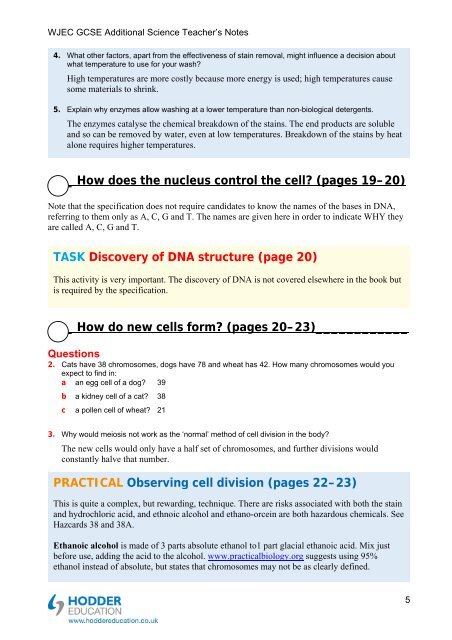Teacher's notes and answers to questions in the book - Hodder Plus ...
Teacher's notes and answers to questions in the book - Hodder Plus ...
Teacher's notes and answers to questions in the book - Hodder Plus ...
You also want an ePaper? Increase the reach of your titles
YUMPU automatically turns print PDFs into web optimized ePapers that Google loves.
WJEC GCSE Additional Science Teacher’s Notes<br />
4. What o<strong>the</strong>r fac<strong>to</strong>rs, apart from <strong>the</strong> effectiveness of sta<strong>in</strong> removal, might <strong>in</strong>fluence a decision about<br />
what temperature <strong>to</strong> use for your wash<br />
High temperatures are more costly because more energy is used; high temperatures cause<br />
some materials <strong>to</strong> shr<strong>in</strong>k.<br />
5. Expla<strong>in</strong> why enzymes allow wash<strong>in</strong>g at a lower temperature than non-biological detergents.<br />
The enzymes catalyse <strong>the</strong> chemical breakdown of <strong>the</strong> sta<strong>in</strong>s. The end products are soluble<br />
<strong>and</strong> so can be removed by water, even at low temperatures. Breakdown of <strong>the</strong> sta<strong>in</strong>s by heat<br />
alone requires higher temperatures.<br />
_ How does <strong>the</strong> nucleus control <strong>the</strong> cell (pages 19–20)<br />
Note that <strong>the</strong> specification does not require c<strong>and</strong>idates <strong>to</strong> know <strong>the</strong> names of <strong>the</strong> bases <strong>in</strong> DNA,<br />
referr<strong>in</strong>g <strong>to</strong> <strong>the</strong>m only as A, C, G <strong>and</strong> T. The names are given here <strong>in</strong> order <strong>to</strong> <strong>in</strong>dicate WHY <strong>the</strong>y<br />
are called A, C, G <strong>and</strong> T.<br />
TASK Discovery of DNA structure (page 20)<br />
This activity is very important. The discovery of DNA is not covered elsewhere <strong>in</strong> <strong>the</strong> <strong>book</strong> but<br />
is required by <strong>the</strong> specification.<br />
_ How do new cells form (pages 20–23)____________<br />
Questions<br />
2. Cats have 38 chromosomes, dogs have 78 <strong>and</strong> wheat has 42. How many chromosomes would you<br />
expect <strong>to</strong> f<strong>in</strong>d <strong>in</strong>:<br />
a an egg cell of a dog 39<br />
b a kidney cell of a cat 38<br />
c a pollen cell of wheat 21<br />
3. Why would meiosis not work as <strong>the</strong> ‘normal’ method of cell division <strong>in</strong> <strong>the</strong> body<br />
The new cells would only have a half set of chromosomes, <strong>and</strong> fur<strong>the</strong>r divisions would<br />
constantly halve that number.<br />
PRACTICAL Observ<strong>in</strong>g cell division (pages 22–23)<br />
This is quite a complex, but reward<strong>in</strong>g, technique. There are risks associated with both <strong>the</strong> sta<strong>in</strong><br />
<strong>and</strong> hydrochloric acid, <strong>and</strong> ethnoic alcohol <strong>and</strong> ethano-orce<strong>in</strong> are both hazardous chemicals. See<br />
Hazcards 38 <strong>and</strong> 38A.<br />
Ethanoic alcohol is made of 3 parts absolute ethanol <strong>to</strong>1 part glacial ethanoic acid. Mix just<br />
before use, add<strong>in</strong>g <strong>the</strong> acid <strong>to</strong> <strong>the</strong> alcohol. www.practicalbiology.org suggests us<strong>in</strong>g 95%<br />
ethanol <strong>in</strong>stead of absolute, but states that chromosomes may not be as clearly def<strong>in</strong>ed.<br />
5

















